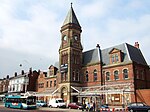Related Research Articles

The Liverpool and Manchester Railway (L&MR) was the first inter-city railway in the world. It opened on 15 September 1830 between the Lancashire towns of Liverpool and Manchester in England. It was also the first railway to rely exclusively on locomotives driven by steam power, with no horse-drawn traffic permitted at any time; the first to be entirely double track throughout its length; the first to have a true signalling system; the first to be fully timetabled; and the first to carry mail.

Huyton is a town in the Metropolitan Borough of Knowsley, Greater Liverpool, Merseyside, England. Part of the Liverpool Built-up Area, it borders the Liverpool suburbs of Dovecot, Knotty Ash and Belle Vale.

Knotty Ash is an area of Liverpool, Merseyside, England, and a Liverpool City Council Ward. Historically in Lancashire, the population at the 2001 Census was 13,200, increasing to 13,312 at the 2011 Census. Knotty Ash is well known as the home of comedian Sir Ken Dodd, who often mentioned it in his act.

Earlestown railway station is a railway station in Earlestown, Merseyside, England, and one of the few "triangular" stations in Britain.

Bryn railway station is a railway station serving the suburb of Bryn in Ashton-in-Makerfield, Greater Manchester, England. The station is situated on the electrified Liverpool–Wigan line 16+1⁄4 miles (26.2 km) northeast of Liverpool Lime Street and 3+3⁄4 miles (6.0 km) south of Wigan. The station, and all trains serving it, are operated by Northern Trains.

The St Helens and Runcorn Gap Railway was an early railway line owned by a company of the same name in Lancashire, England, which opened in 1833. It was later known as St Helens Railway. It ran originally from the town of St Helens to the area which would later develop into the town of Widnes. Branches were opened to Garston, Warrington and Rainford. The company was taken over by the London and North Western Railway in 1864. The line from St Helens to Widnes and the branch to Rainford are now closed, the latter terminating at the Pilkington Glass' Cowley Hill works siding near Gerard's Bridge, but part of the lines to Garston and to Warrington are still in operation.
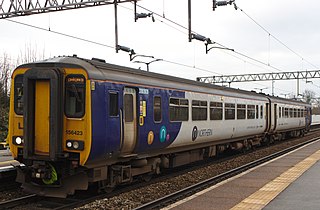
There once were four direct railway routes between Liverpool and Manchester in the North West of England; only two remain, the two centre routes of the four. The most northerly and the most southerly of the four routes are no longer direct lines. Of the remaining two direct routes, the northern route of the two is fully electric, while the now southern route is a diesel-only line. The most northerly of the four has been split into two routes: the western section operated by Merseyrail electric trains and the eastern section by diesel trains, requiring passengers to change trains between the two cities. The fourth route, the most southerly of the four, has been largely abandoned east of Warrington; the remaining section caters mainly for freight trains.
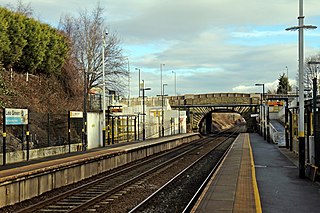
Lea Green railway station is in St Helens, Merseyside, England, three miles south of the town centre near the suburb of Clock Face. The station is on the electrified northern route of the two Liverpool to Manchester lines, 10+3⁄4 miles (17 km) east of Liverpool Lime Street. Northern Trains operates the station with Merseytravel sponsorship displaying Merseytravel signs. Constructed in 2000, the station has a park and ride car park fitted with charging points for electrically-powered vehicles, a modern CCTV security system and a booking office at street level.

The Liverpool–Wigan line is a railway line in the north-west of England, running between Liverpool Lime Street and Wigan North Western via St Helens Central station. The line is a part of the electrified Merseyrail Liverpool to Wigan City Line. The stations, and all trains serving it, are operated by Northern Trains, however the stations are branded Merseyrail using Merseyrail ticketing.

Eccles railway station serves the town of Eccles, Greater Manchester, England. It was opened on 15 September 1830 by the Liverpool and Manchester Railway (L&M).
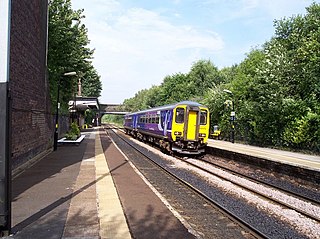
Roby railway station serves the village of Roby, Merseyside, England. It is located 5 miles (8.0 km) east of Liverpool Lime Street on the former Liverpool and Manchester Railway, and 1⁄2 mile (800 m) west of Huyton. It is operated by Northern Trains, as part of Merseytravel's electrified City Line to Manchester and Wigan North Western.

Huyton railway station serves Huyton in Merseyside, England. The station is an interchange between the Liverpool-Wigan Line and the northern route of the Liverpool-Manchester Line which diverge soon after the station. It is one of the busier stations on the lines and close to the shopping centre and bus station.

Rainhill railway station serves the district of Rainhill in Merseyside, England. It is situated on the electrified northern route of the Liverpool to Manchester Line, forming part of the Liverpool City Line. The station, and all trains serving it, are operated by Northern Trains on behalf of Merseytravel and are branded as Merseytravel services.
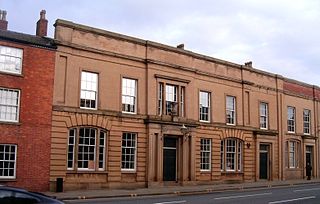
Liverpool Road is a former railway station on the Liverpool and Manchester Railway in Manchester, England; it opened on 15 September 1830. The station was the Manchester terminus of the world's first inter-city passenger railway in which all services were hauled by timetabled steam locomotives. It is the world's oldest surviving terminal railway station. With tracks running at a first floor level behind the building, it could also be considered one of the world's first elevated railway stations.
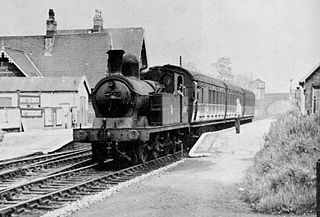
Northenden railway station in Sharston, Manchester, England, was built by the Stockport, Timperley and Altrincham Junction Railway (ST&AJ) and opened for passenger and goods traffic on 1 February 1866.

Baguley railway station was a station in the south of Manchester, England, at the extreme western edge of Baguley near the southern end of Brooklands Road where Shady Lane crossed the railway line.

The Northern Hub was a rail upgrade programme between 2009 and 2020 in Northern England to improve and increase train services and reduce journey times between its major cities and towns, by electrifying lines and removing a major rail bottleneck in Manchester. It was predicted to stimulate economic growth in the region. The project had several elements but the prime objective was to eradicate the bottleneck in Manchester and allow trains to travel through the city at speed without stopping. The project was announced as the Manchester Hub in 2009. The project's steering partnership involved Network Rail, Deutsche Bahn, First TransPennine Express, Northern Rail, East Midlands Trains, CrossCountry, Freightliner, the Department for Transport, Transport for Greater Manchester and Merseytravel.
Parkside railway station was an original station on the Liverpool and Manchester Railway. It then became the interchange station between lines when the Wigan Branch Railway opened in 1832, moving to the physical junction of the two lines in 1838. The station continued as an interchange until being by-passed in 1847 when a west curve was opened to facilitate north–south links that did not go through the station. Traffic declined further after the Winwick cut-off opened in 1864 leading to closure in 1878.

Lowton railway station served the village named Town of Lowton to the east of Newton-le-Willows and south of Golborne.
Lamb's Cottage was a short-lived, original railway station on the Liverpool and Manchester Railway to the southeast of Astley village in what was then the county of Lancashire, England. The station was 32 chains (0.64 km) east of what later became Astley station and in 2015 was Astley signal box and level crossing carrying Rindle Road.
References
- 1 2 Butt, R. V. J. (1995). The Directory of Railway Stations: Details Every Public and Private Passenger Station, Halt, Platform and Stopping Place, Past and Present. Sparkford: Patrick Stephens Ltd. p. 126. ISBN 9781852605087. OCLC 60251199. OL 11956311M.
- ↑ Holt, G. O. (1965). A Short History of the Liverpool and Manchester Railway (2nd ed.). The Railway and Canal Historical Society. p. 22.



